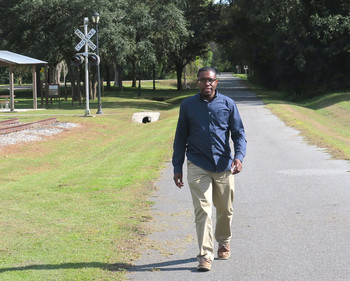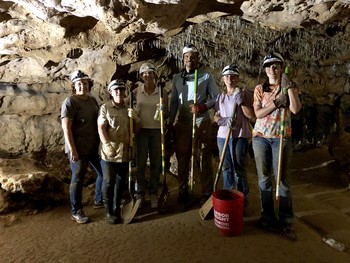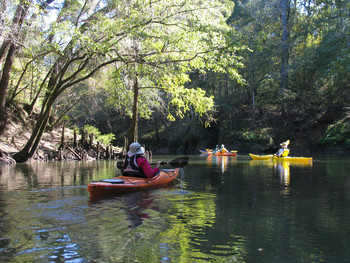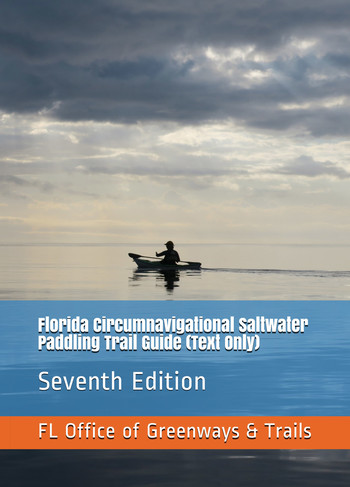|
Summer 2019
 By Donald Morgan, OGT Regional Coordinator
As one of three regional trail coordinators for the Office of Greenways and Trails (OGT), I am tasked with providing trail coordination and planning for the East-Central Region (Region 2) of the Florida Greenways and Trails System. In addition to working with my region, I lead efforts for coordinating long-distance trails and provide master planning support.
Region 2 is a vibrant hub for Florida trails as it is home to three long-distance shared-use regional trail systems: The East Coast Greenway, The Heart of Florida Loop, and the St. Johns River-to-Sea Loop and many other land and water trail networks. In my eight-month tenure as Regional Coordinator, I have been fortunate to meet great trail champions and see awesome, cutting-edge trail projects.
Back in April, Florida State Parks Director Eric Draper and I joined the Town of Hastings in celebrating the completion of its 3-mile segment of the Palatka-to-St. Augustine State Trail. In coordination with the event planners, OGT provided new kiosk maps for the state trail, all of which feature “You are Here” points to aid wayfinding. In addition, OGT provided keepsake rack cards that highlight the St. Johns River-to-Sea Loop and the Hastings Rail Trail. A great time was had by cyclists, community residents, vendors and trail champions alike.
Speaking of the St. Johns-River-to Sea Loop, we are gearing up for another exciting Loop Summit, this one to take place in Titusville in March 2020. OGT is working closely with the planning committee to organize an informative summit, including educational breakout sessions and an action workshop. Stay tuned for more information!
I am also excited about the continuing progress of the 250-mile Florida Coast-to-Coast Trail (C2C). Regional Coordinator Katie Bernier and I are working to develop a data book, a multipurpose tool that would feature completed trail segments, segment lengths, amenities along the segments, as well as gaps and anticipated completion dates. We are working our way around the C2C, meeting with segment managers.
 By Eric Draper, Florida State Parks Director
On June 14th, over 100 Department of Environmental Protection staff arrived at Florida Caverns State Park equipped with helmets, flashlights and shovels. It was the final push to help restore the caverns after Hurricane Michael. The group formed a bucket brigade and began hauling load after load of mud out of Florida’s only public cave system, while others cleaned the museum and spread gravel on trails.
The task was trying, but worth it. People volunteered to spend a day doing incredibly tough and dirty work so that everyone can enjoy the park.
Florida’s parks, greenways and trails are a public treasure, providing millions of visitors with access to green spaces and recreation opportunities. Protecting these lands is a priority for DEP and for local communities.
Thanks to the hard work of staff, partners and local volunteers, Florida Caverns State Park is again welcoming visitors. It’s the final state park to reopen of the 31 that were damaged by Hurricane Michael.
Each damaged park had a band of supporters. They were staff, local leaders and residents who saw their park as a symbol of resilience after the storm. Conversations with them strengthened my belief that communities need places to get active and experience nature, especially through hardship.
As Floridians we have much to celebrate during Recreation and Parks Month. You can help by leading others to recognize the value of getting outdoors. It’s easy to do — invite a friend or colleague to a new trail or take the kids on a weekend paddling trip. We need places to play, and those places need us to enjoy and share them with others.
 Here’s one way to help communities recovering from Hurricane Michael: Paddle their waterways and spend a few dollars at local businesses while you’re at it. The Chipola River below Florida Caverns State Park in Jackson County from Yancey Bridge to Peacock Bridge is now free of fallen trees, a 20-mile stretch, thanks to funding provided by the Florida Department of Environmental Protection (DEP). This spring-fed river flows past high bluffs and even a cave, with few signs of humanity. The Chipola River Paddling Trail Guide provides everything you need to know for planning your trip. Due to some tight turns and swift currents, the river is recommended for intermediate and experienced paddlers. Additionally in Jackson County, the Merritt’s Mill Pond and Ocheesee Pond paddling trails make for wonderful and easy day trips.
Some fallen trees are still present in the Chipola River below Jackson County, but paddlers are able to navigate around them. Elsewhere in the Panhandle, Econfina Creek is open from the Econfina Canoe Livery to the County Road 388 Bridge, and Holmes Creek is open from Cotton Landing to the town of Vernon.
 In preparation for the 2019-20 paddling season, which begins in October, all 26 segments of the 1,515-mile Florida Circumnavigational Saltwater Paddling Trail have recently been updated. Several weblinks were revised and some changes to hotels along the way. Mexico Beach overnight accommodations were updated in the wake of Hurricane Michael with one hotel set to reopen next year. Another primitive campsite has been added to Waccasassa Bay Preserve State Park in coordination with park officials. As part of the update, the printed guide for the trail has also been updated and is available on Amazon.
OGT coordinates the trail and relies on long-distance paddlers and volunteers with the Florida Paddling Trails Association to be their eyes and ears on the water, alerting staff of any needed changes for the guide.
“By paddling the Circumnavigational Trail, you get to see parts of Florida you’ve never seen," said John Shinner, one of several people paddling the entire trail in segments over several years. "If you have the option, take your time and really enjoy what the trail has to offer.”
|